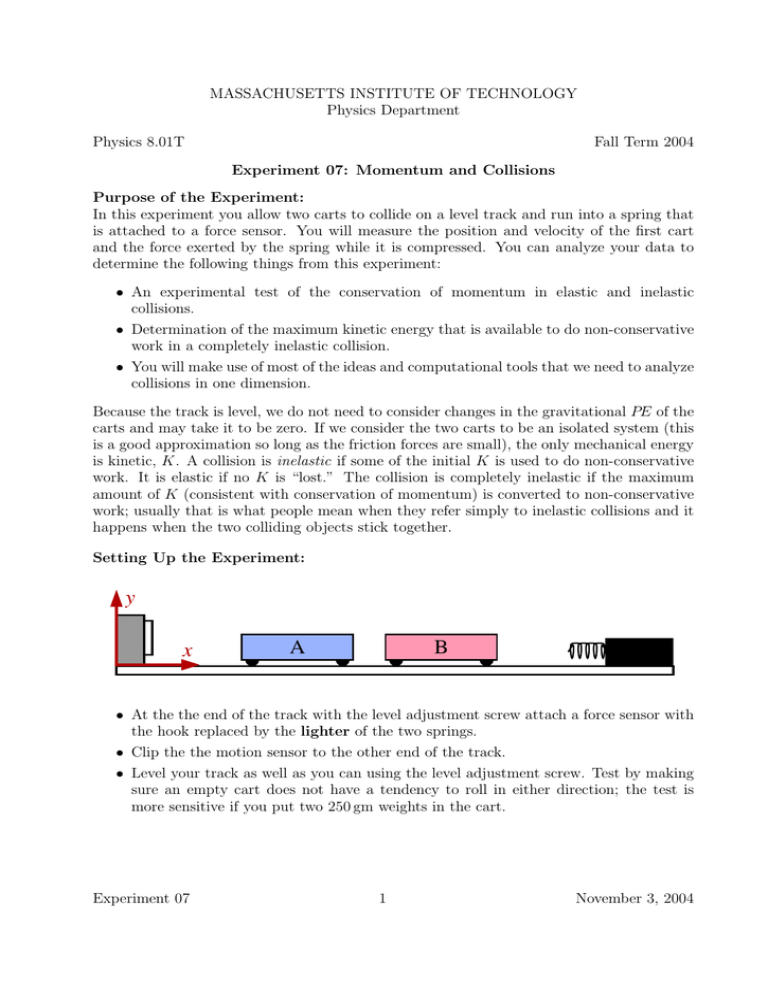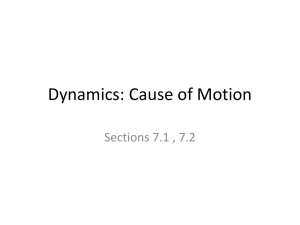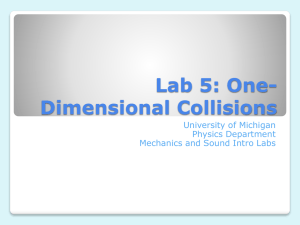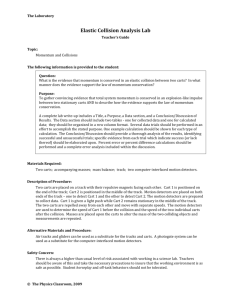Document 13605635
advertisement

MASSACHUSETTS INSTITUTE OF TECHNOLOGY Physics Department Physics 8.01T Fall Term 2004 Experiment 07: Momentum and Collisions Purpose of the Experiment: In this experiment you allow two carts to collide on a level track and run into a spring that is attached to a force sensor. You will measure the position and velocity of the first cart and the force exerted by the spring while it is compressed. You can analyze your data to determine the following things from this experiment: • An experimental test of the conservation of momentum in elastic and inelastic collisions. • Determination of the maximum kinetic energy that is available to do non­conservative work in a completely inelastic collision. • You will make use of most of the ideas and computational tools that we need to analyze collisions in one dimension. Because the track is level, we do not need to consider changes in the gravitational PE of the carts and may take it to be zero. If we consider the two carts to be an isolated system (this is a good approximation so long as the friction forces are small), the only mechanical energy is kinetic, K. A collision is inelastic if some of the initial K is used to do non­conservative work. It is elastic if no K is “lost.” The collision is completely inelastic if the maximum amount of K (consistent with conservation of momentum) is converted to non­conservative work; usually that is what people mean when they refer simply to inelastic collisions and it happens when the two colliding objects stick together. Setting Up the Experiment: y x A B • At the the end of the track with the level adjustment screw attach a force sensor with the hook replaced by the lighter of the two springs. • Clip the the motion sensor to the other end of the track. • Level your track as well as you can using the level adjustment screw. Test by making sure an empty cart does not have a tendency to roll in either direction; the test is more sensitive if you put two 250 gm weights in the cart. Experiment 07 1 November 3, 2004 Setting up DataStudio: • Connect the force sensor and set it to a 500 Hz sample rate with low sensitivity. Tare the sensor when nothing is in contact with the spring. • Connect the motion sensor and calibrate it. Choose the trigger rate to be 80, and set it to measure position and velocity (acceleration is optional). • Set the sampling options for Delayed Start to “position rises above 0.3m” and do not keep any data prior to the start. Set Automatic Stop to “position falls below 0.3m.” Create graphs to plot force, position and velocity as a function of time by dragging entries from the Data window onto the Graph icon in the Displays window. Inelastic Collisions: You should study inelastic collisions first in this experiment. Place two empty carts on the track with the the Velcro pads facing each other. One cart (which I call the target cart, with mass mB ) should be placed on the track with the end with the Velcro pads about 70 cm from the motion sensor; then the other end of the cart will be about 10 cm from the spring on the force sensor. The second cart (which I will call the incident cart, with mass mA ) should be placed on the track between 16 cm and 20 cm from the motion sensor. You should push the incident cart just hard enough that it comes back to the starting point after colliding with the other cart and bouncing off the spring. If you push it too hard it may jump during the collision with the target cart, and if you push it too softly it will not come back far enough to stop DataStudio from taking data. Experiment 07 2 November 3, 2004 You should experiment to get this right before you start to make measurements. How hard you need push it changes with the masses of the two carts and whether or not the collision is inelastic, so you will have to find this out for each of the six measurements that you make To make a measurement, click the DataStudio start button and start the incident cart rolling towards the target. The cart will roll at least 10 cm before data are recorded; that gives it time to stabilize and roll smoothly after you push it. Make measurements with mA = mB = 250 gm (both carts empty), mA = 250 gm, mB = 500 gm, and mA = 500 gm, mB = 250 gm. Measure vA,1 before the carts collide and v2 = vA,2 = vB,2 after the collision when the two carts are stuck together but have not yet hit the spring. (Notation: the subscripts A and B refer to the carts, and subscripts 1 and 2 are before and after the carts collide, respectively.) My results are in the two graphs below. Velocity vs. Time Position vs. Time The best way to measure vA,1 is to select the velocity data before the collision and use the statistics tool (Σ) on the graph to find the average—as shown on the graph below. Then select the data after the collision (but before the cart hits the spring) to measure v2 . You will not need the force sensor data for the inelastic collisions. Record the values of vA,1 and v2 for each col­ lision in the table below. mA mB 0.25 kg 0.25 kg 0.25 kg 0.50 kg 0.50 kg 0.25 kg Experiment 07 vA,1 (m/s) v2 (m/s) 3 November 3, 2004 Elastic Collisions: These measurements will be done exactly like the preceding ones except the carts are placed on the track with the opposite ends (the ones containing magnets) facing each other. Then the collision between the carts will be elastic. You should measure collisions with mA = mB = 250 gm (both carts empty), mA = 250 gm, mB = 750 gm, and mA = 750 gm, mB = 250 gm. Measure vA,1 (before) and vA,2 (after the carts collide, but before the target cart bounces back to hit the incident cart). The motion sensor can only measure the velocity of the incident cart. You know the initial velocity of the target cart, vB,1 , is zero, and you can find vB,2 after the collision from the impulse given to the target cart by the spring. Here is how to do it. at the left 1. Use a combination of selecting points and the “Scale to Fit” button of the graph’s toolbar to expand the force graph to show only the time around the collision of the target cart with the spring, like this 2. Open the pull­down menu next to the Σ on the graph’s tool bar. Check the “Area” item at the bottom of the menu. Uncheck the other items. 3. Select the data points that correspond to the collision (F > 0) and click the Σ symbol (statistics tool). Then DataStudio will calculate the time integral of the force (the impulse, J) and display the result in a box similar to that on the graph above. 4. The post­collision velocity vB,2 is given by the impulse J/(2mB ). Experiment 07 4 November 3, 2004 Record the values of vA,1 , vA,2 and J for each collision in the table below. Use S.I. units (m s−1 or N s). mA mB 0.25 kg 0.25 kg 0.25 kg 0.75 kg 0.75 kg 0.25 kg vA,1 vA,2 J Analysis of Your Measurements: Your data analysis will be carried out as the part of Problem Set 9 which is attached as the last three pages of these notes. If you have time after completing your measurements, I suggest that you embark on this analysis now. You will need the data from the table above and from the table on page 3 to do the homework problem; make sure that you take a copy with you. Experiment 07 5 November 3, 2004 Appendix: Magnetic Force This is not part of the experiment you are asked to do (you may try it if you want a challenge) and is presented for your information. When the carts collide elastically, they exert forces on each other by the repulsion between two pairs of magnets. In Experiment 03 we measured the force law between two rectangular ceramic magnets. I was able measure the force law between the two carts. Here is how. I replaced the spring on the force sensor with a more solid support (a gadget that looks like the force sensor springs, but without the spring attached). Next, I raised the motion sensor end of the track by about 4 cm, as we did in Experiment 06, rested cart B against the force sensor, and allowed cart A to roll down and run into it. I selected force and position data only from the time when the carts were first 40 mm apart to the point of closest approach. The graph below shows my results and the result of fitting them to the expression A*exp((D­x)/C)+B. The fit is very good (RMS error ±0.05 N). It shows that the repulsion between the two carts can be described as a decaying exponential with a 1/e length of 5.2 mm. Knowing the force law of the magnetic “spring” between the two carts, we can calculate their distance of closest approach during the collision. You are asked to do this in a problem in Problem Set 9, due November 9. See the last three pages of these notes. Experiment 07 6 November 3, 2004 MASSACHUSETTS INSTITUTE OF TECHNOLOGY Physics Department Physics 8.01T Fall Term 2004 Part of Problem Set 09 Section and Group: Your Name: Part One: Inelastic Collisions Analysis: Complete the analysis of your data table by following the two steps below, and answer Question 1 below. You will analyze this collision as seen by two different observers. One observer is at rest with respect to the classroom; this reference frame is called the lab reference frame. The other observer is moving at a velocity equal to the center of mass velocity of the two­cart system. This frame is called the center of mass reference frame. Step 1: Draw two momentum diagrams for both carts immediately before and immediately after the collision, one describing the collision in the lab reference frame, and one describing the collision in the center of mass reference frame. Step 2: You made three different trial collisions; the first with equal masses, and the second and third with unequal masses. Use your measured values to complete the foillowing table. Entries to the left of the double vertical bar are before the two carts collide; those to the right are after the carts collide but before the collision with the force sensor. Hand in the table with your homework solutions. mA mB 0.25 kg 0.25 kg 0.25 kg 0.50 kg 0.50 kg 0.25 kg vA,1 vCM K1 KCMCS v2 K2 WNC a) First calculate the initial kinetic energy K1 and the final kinetic energy K2 in the ‘lab reference frame’. The difference between the two, K2 − K1 = WNC , is the non­ conservative internal work, WNC = Kf − K0 , due to the totally inelastic collision. This work is due to forces that irreversibly deform the bodies during the collision. Momentum 7 Due November 9, 2004 b) Then calculate the velocity of the center of mass, which is given by �vCM = mA�vA,1 . mA + mB Because momentum is conserved, you should expect �vCM = �v2 . Calculate the total kinetic energy of the two carts in the center of mass reference frame, given by 1 1 2 KCMCS = mA (vA,1 − vCM )2 + mB vCM 2 2 Question 1: In the center of mass reference frame the incident cart A moves forward with a slower velocity, �vA,1 − �vCM , than in the lab frame; the cart B moves backward with a velocity −�vCM . After the collision the two carts are stuck together and are at rest in the center of mass frame, so the final kinetic energy in this frame is Kf� = 0. Therefore the non­conservative work in the center of mass reference frame is given by WNC = Kf� − KCMCS = −KCMCS . Show that Kf − K0 = −KCMCS . This will require a calculation. Do your experimental data verify this theoretical result ? Part Two: Elastic Collisions Analysis: Complete the analysis of your data table by following the two steps below, and answer Question 2 below. Once again you made three trials. Since the motion sensor can only measure the initial and final velocities of the incident cart A, you need to calculate the impulse of the target cart B on the force sensor to determine the final velocity of cart B. Step 1: Draw a momentum diagram for the collision immediately before the cart B hits the force sensor and just after cart B rebounds from the force sensor. Step 2: If we assume that cart B collides elastically with the force sensor, the momentum of cart B changes by Δ�pB = −2mB �vB,2 . This change in momentum is the impulse that the force sensor exerts on the target cart B. Cart B therefore exerts an equal and opposite impulse on the force sensor with magnitude J = 2mB vB,2 . So measuring the impulse allows you to calculate the velocity of the target cart after the collision, vB,2 = J/2mB . Use your measured values to complete the following table. Entries to the left of the double vertical bar are before the two carts collide; those to the right are after the carts collide but before the collision with the force sensor. Hand in the table with your homework solutions. mA mB 0.25 kg 0.25 kg 0.25 kg 0.75 kg 0.75 kg 0.25 kg Momentum vA,1 vCM K1 8 vA,2 J vB,2 K2 Due November 9, 2004 Question 2: Assume that the collision between the carts is elastic. Use the principles of conservation of momentum and of mechanical energy to calculate the theoretical post­collision velocites for cart A and cart B for each of the three trials. Show your work. (These calculations are more complicated for the cases where the carts have different masses.) Briefly describe whether or not your measured values agree with your theoretical values. Do you results confirm that the collisions are elastic ? Modeling the Elastic Collision: Question 3: The repulsive force between two carts is modeled by the force law F = Ae−x/� where x is the separation between the carts and � is a characteristic length associated with the magnets in the carts. If the carts start very far apart (an infinite distance), the work required to bring them to a separation distance d is: � d � d F(s) · ds = −A W = ∞ e−s/� ds ∞ Calculate this integral. The result is the equivalent of the potential energy stored in a spring ( 21 kx2 ) that satisfies a linear restoring force law. Question 4: Suppose there are two of these carts on a track. One cart with mass m and initial speed vA,1 runs into the other, which has equal mass and is initially at rest on the track. Find the minimum separation d between the carts during the collision. You may assume that A is sufficiently large so that d > �. Evaluate your result numerically using A = 2.0 × 101 N, � = 5 × 10−3 m, m = 2.5 × 10−1 kg, and vA,1 = 5.0 × 10−1 m/s. Hint: this problem is most easily done in the center of mass reference frame. Momentum 9 Due November 9, 2004




